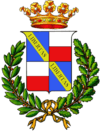Bagni di Lucca
| Bagni di Lucca | ||
|---|---|---|
| Comune | ||
| Comune di Bagni di Lucca | ||
 | ||
| ||
 Bagni di Lucca | ||
| Coordinates: 44°0′34″N 10°34′46″E / 44.00944°N 10.57944°E | ||
| Country | Italy | |
| Region | Tuscany | |
| Province | Lucca | |
| Frazioni | Bagni Caldi, Benabbio, Brandeglio, Casabasciana, Casoli, Cocciglia, Crasciana, Fabbriche di Casabasciana, Fornoli, Granaiola, Isola, La Villa, Limano, Lucchio, Lugliano, Montefegatesi, Monti di Villa, Palleggio, Pieve di Contron, Pieve di Monti di Villa, Ponte a Serraglio, San Cassiano di Controni, San Gemignano, Val Fegana, Vico Pancellorum (list is incomplete) | |
| Government | ||
| • Mayor | Giancarlo Donati (Forza Italia) | |
| Area | ||
| • Total | 164.65 km2 (63.57 sq mi) | |
| Elevation | 150 m (490 ft) | |
| Population (2008) | ||
| • Total | 6,541 | |
| • Density | 40/km2 (100/sq mi) | |
| Demonym | Bagnaioli | |
| Time zone | CET (UTC+1) | |
| • Summer (DST) | CEST (UTC+2) | |
| Postal code | 55022 | |
| Dialing code | 0583 | |
| Patron saint | Saint Peter and Saint Paul | |
| Saint day | 29 June | |
| Website | Official website | |
Bagni di Lucca (formerly Bagno a Corsena)[1] is a comune of Tuscany, Italy, in the Province of Lucca with a population of c. 6,500.
History
Bagni di Lucca has been known for its thermal springs since the Etruscan and Roman ages. The locality was noted for the first time in an official document of 983CE, with reference to a donation by the Bishop Teudogrimo of the territory of Bagni di Lucca to Fraolmo of Corvaresi.
Between the 10th and 11th centuries, the village became a feudal property. It was held first by the Suffredinghi family, then the Porcareschi, and later the Lupari. In the 12th century, the commune of Lucca occupied the territory of Bagni di Lucca. In 1308 Lucca unified the community of Bagni di Lucca with those of the nearby villages, forming a Vicarship named "Vicarship of the Lima Valley".
During the 14th century, recognizing the revenue from visitors to the thermal springs of Bagni di Lucca, Lucca restored the town. The commune developed it as a destination, a relaxing and enjoyable oasis that attracted numerous visitors, including international figures.
Bagni di Lucca and its thermal baths reached its peak of notability during the 19th century, especially during the French occupation. The town became the summer residence of the court of Napoleon and his sister, Elisa Baciocchi. A casino was built, where gambling was part of social nightlife, as well as a large hall for dances.
At the Congress of Vienna (1814), the Duchy of Lucca, including Bagni di Lucca, was assigned to Maria-Louisa, a Bourbon Sovereign of Parma.[2] It continued as a popular summer resort, particularly for the English, who built a Protestant church there (still extant).[3] In 1847 Lucca with Bagni di Lucca was ceded to the Grand Duchy of Tuscany, under the domain of the Grand Duke Leopold II of Lorraine.[4] His rule started a period of decline for the springs and casino as a destination, since he was used to a secluded life. In 1853 the casino was closed. It was reopened after 1861, when Lucca became part of the unified Kingdom of Italy.[5]
In the meantime, the economy became diversified. Residents developed crafts and manufactured paperboard, chalk and plastic.
Main sights
In the valley of the Serchio, c. 5 km below Ponte a Serraglio, is the medieval Ponte della Maddalena (circa 1100), with a lofty central arch. It is also known as Ponte del Diavolo.[6] Also notable is the pieve (rural parish church) of San Cassiano, built by 722. It has the painting St. Martin Riding by Jacopo della Quercia and others from the Renaissance. Additional Renaissance works hang in the pieve of San Paolo a Vico Pancellorum (built 873).
The hospital in the frazione of Bagno Caldo was built in 1826 by the philanthropy of Nicholas Demidoff.[6]
Hot springs
The commune is known for its springs which are situated in the valley of the Lima River, a tributary of the Serchio river. The district is known in the early history of Lucca as the Vicaria di Val di Lima. Ponte Serraglio is the principal village of the warm spring area, but there are warm springs and baths also at Villa, Docce Bassi, and Bagno Caldo. The springs do not seem to have been known to the Romans. Bagno a Corsena is first mentioned in 1284 by Guidone de Corvaia, a Pisan historian (Muratori, R.I.S. vol. xxii.).
Fallopius, who gave the springs credit for the cure of his own deafness, sounded their praises in 1569; and they have been more or less in fashion since. The temperature of the water varies from 36°C to 54°C. In all cases, the springs give off carbonic acid gas and contain lime, magnesium and sodium products.[1]
Economy
The local economy is mainly based on tourism, attracted to the thermal springs, the historic architecture, and numerous quality hotels.
Local industries produce paper and building materials, as well as machines.
References
| Wikimedia Commons has media related to Bagni di Lucca. |
- ↑ 1.0 1.1
 This article incorporates text from a publication now in the public domain: Chisholm, Hugh, ed. (1911). "Lucca, Bagni di". Encyclopædia Britannica 7 (11th ed.). Cambridge University Press. p. 95
This article incorporates text from a publication now in the public domain: Chisholm, Hugh, ed. (1911). "Lucca, Bagni di". Encyclopædia Britannica 7 (11th ed.). Cambridge University Press. p. 95 - ↑ Starke M. Travels in Europe 9th Edition, John Murray, 1837, p48
- ↑ Starke (1837), pp 106-111
- ↑ Baedeker K. (1899) Northern Italy 11th Edition, Leipsic p395
- ↑ Baedeker (1899), p400
- ↑ 6.0 6.1 Chisholm 1911.
